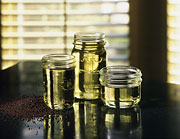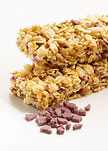
“The characteristics of a 'healthy' oil are relative,” says Gerald McNeill, PhD, director of R&D and marketing for a palm-oil supplier. “Every oil has its strengths and weaknesses.” Nevertheless, while polyunsaturated oils may be healthier, they are less functional in baked goods, where a semi-solid fat with high stability and long shelflife is required. Although trans and saturated fats exhibit similar functionality and shelflife properties, most researchers consider trans fat to be less healthy than saturated fat.
Trans or Saturated Fat
William Archer, MD, a physician and former commissioner of health for the state of Texas, worked as a liaison between the moderator and respected academic panelists at the Trans Fat Replacement Roundtable, held on May 13, 2005 in New York, and sponsored by a prominent palm oil supplier. Manufacturers are wondering what they should replace trans fat with—palm or interesterified-stearic acid from soybean oil, notes Archer. Currently, no agreement has been reached as to whether interesterified-soy oil is superior to palm oil, he concludes.What matters most is how a particular type of oil affects the Nutrition Facts panel. However, most companies use more than one oil to replace trans fat; they use a blend. “At our company, we provide custom oil blends to address unique product requirements,” says Willie Loh, PhD, market development manager for a specialty-oil supplier. In many ways, it is not necessarily the type of oil that is important, but whether or not the Nutrition Facts Panel reads zero grams of trans fat and low levels of saturated fat. Some believe that referring to an oil as a saturated or unsaturated fat can mislead manufacturers and consumers, since either term can refer to an oil that contains different proportions of saturated and unsaturated fats.
“Most food companies say that shifting trans fats to saturated fats simply postpones the problem,” opines Loh. Consumers understand that both saturated and trans fats are bad. “They don't say I'll eat this one because it's slightly less bad,” he jokes.

A Miscible Matter
One of the most popular substitutes for trans fat is palm oil. Palm oil has excellent functionality in baked goods. The main saturated fat in palm oil is palmitic acid. It is made in the human body and is necessary for proper function in human cells.Palm oil is relatively similar to body fat and can act as a human milk-fat replacer in infant formula. The predominant fatty acids in human milk fat are palmitic and oleic acids.
Unfortunately, newborn babies cannot digest palmitic acid very efficiently when it is located in the first or third position on the triglyceride backbone. How-ever, when palmitic acid is placed in the middle or second position with the use of enzyme technology during fat processing, it matches human milk fat almost exactly, notes one palm oil supplier.
This is important because animal and human studies show that when palmitic acid is in the one or three position, it combines with calcium during digestion and is especially hard for newborns to absorb. Therefore, the baby receives less energy than intended and only part of the calcium, because some of it is excreted instead of absorbed. In the second position, that problem is eliminated. In addition, human milk fat contains docosahexaenoic acid (DHA). Thus, infant formulas have been enriched with DHA to match the fatty acid composition of human milk fat.
Algae On the Rise
Aside from contributing to brain and eye development of infants and children, DHA, a form of omega-3, lowers triacylglycerols in blood and is a marker for heart disease. DHA and eicosapentaenoic acid (EPA), which are increasingly used to enrich many food products, are obtained from many different sources—most notably through fish consumption. Unfortunately, controversy over mercury levels in fish inhibits some consumers from eating it. “I believe oil derived from micro-algae is one of the best sources of DHA to fortify foods,” says Ruben Abril, director of product development for a DHA algae supplier.Microalgae can be formulated into vegetarian products, since it is a plant source as opposed to a fish source.
Recommended fortification amounts of DHA range from 35mg per serving to 100mg per serving depending on the application, suggests Abril. With a DHA concentration of 350mg per gram of oil, it is possible to fortify some products with higher levels. Once it goes into the food matrix, DHA is somewhat protected and not exposed, since only a small amount of it is added. Furthermore, encapsulation of omega-3s minimizes exposure to air and gives added protection to the oil which, in turn, helps ensure a longer shelflife for some foods.
Although this is a highly contested subject, many researchers believe that the human body is inefficient in elongating ALA (Alpha Linolenic Acid) from vegetable oils, such as flax oil, to DHA. “The conversion to DHA is very low, and considering the conversion rate, a significant amount of ALA is needed to make the conversion, and arrive at a meaningful level of DHA, adds Abril.
Manufacturers are using omega-3 oils in everything from yogurts, spreads, cheese and chocolate milks to baked products such as nutritional bars, cookies, crackers and even orange juice and confections.
Burning the Midnight Oil
Although oils most often are equated with unwanted fat, there are a couple of oils that are getting attention because of their fat-reducing qualities.“There is speculation about the mechanism of how conjugated linoleic acid (CLA) blocks fat deposition,” says McNeill. “It's not black or white because the body is always losing or gaining fat on a daily basis.” It is believed that CLA helps the body oxidize fat and reduce fat cells.
CLA was originally discovered in beef fat and is found in many dairy products, but now it can be converted from sunflower and safflower oil. There are varying forms of CLA with various nutritional properties. There also is a form of CLA that is said to boost immune function.
Diacylglycerol (DAG) also facilitates the burning of body fat. DAG is the main ingredient in Enova cooking oil, which may be used to lower cholesterol. Enova also includes plant sterols to prevent complete absorption of cholesterol after a meal, resulting in lower levels of blood cholesterol, especially levels of LDL (the “bad” cholesterol).
“Clearly defining the product positioning and a complementary nutritional objective, in addition to selecting a healthier fat system and reformulating to the nutritional objective, may require tweaking the recipe, modifying the manufacturing process and even changing the packaging material,” says Loh.
Formulating products with healthy oils requires a good relationship with a knowledgeable supplier, processing procedures that minimize oxidation and an informed consumer base.
Showcase: Fats and Oils, and Omega-3s
Omega-3 oils have been traditionally used as ingredients in nutritional supplements. The benefits are said to include a lowered risk of cardiovascular disease, cholesterol regulation, reduced hypertension and depression, and enhanced immune system. Omega-3 oils available from Arista Industries include omega-3 oils from both fish and plant sources in a variety of potencies in liquid and powder forms. The new powder form can be used in food products including, but not limited to powdered drinks, energy bars, cereals, baby formulas and dairy and bakery items. Arista Industries Inc., Mary Ann Siciliano, 203-761-1009, ext. 316, maryann@aristaindustries.com
Utilizing Wright's proprietary SMART™ microencapsulation technology, SuperCoat Omega-3™ provides a tasteless, odorless, ready-to-use functional dry powder with excellent process properties that can be used in a range of bakery products, functional foods and nutritional supplements. Super Coat Omega-3 is available in two different powders. One is formulated to deliver a 2:1 ratio of eicosapentaenoic acid (EPA) and docosahexaenoic acid (DHA) and the other emphasizes the benefits of DHA on cognitive health, by delivering a 2:1 ratio to EPA. Custom powders are available. The Wright Group, Monique Roberts, 800-201-3096, monique@wenrich.com, www.thewrightgroup.net
This taste-free, odorless, kosher and organic ingredient is easily incorporated into current formulations and offers simple, clean labeling opportunities. OmegaPure® from Omega Protein is the only fish oil source of omega-3 long-chain essential fatty acids with direct FDA GRAS approval and is rich in both EPA and DHA—important properties for health maintenance. In fact, inclusion of OmegaPure may allow for a health claim right on the label, letting consumers know that a product is heart healthy. Omega Protein, 877-866-3423

Consumers are becoming increasingly aware that DHA is the key omega-3 for brain, eye and heart health. Martek DHA™, the same DHA omega-3 used in infant formula and trusted by parents, is available for food/beverage applications. Martek DHA is from a patented, vegetarian source (algae), making it an ideal choice. The DHA is free of oceanic pollutants, works well in a variety of food applications, will not compromise the food's sensory characteristics and has a long shelflife. Martek Biosciences Corporation, Jay Ragan, 443-542-2160, JRagan@martekbio.com